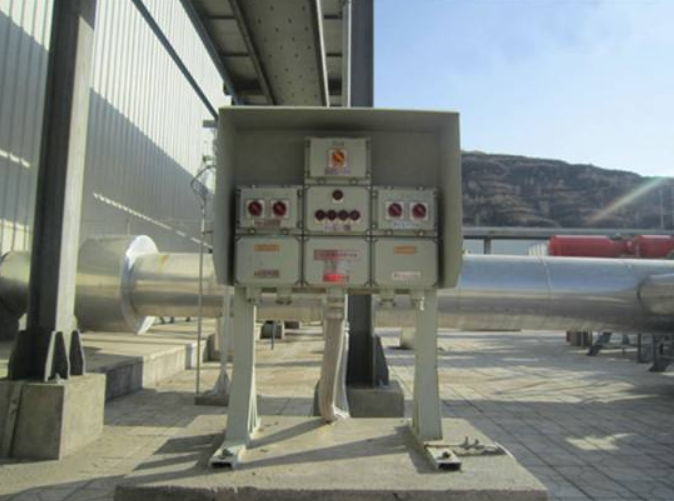
随着我国经济建设高速发展,工业生产规模日益增大,防爆问题显得更为重要。在石油、化工、煤炭、等各行业,功能各异、品种繁多的防爆电器产品被广泛采用。防爆电器在选用、安装、使用及维护上需严格遵守国家相关法律法规及国家标准。深圳中诺检测技术有限公司在防爆领域拥有丰富的产品设计及测试经验,以下是有关防爆电气的安装、检查、维护及使用注意事项的简述。
1.1 电气设备的配电要求
1.1.1 进入爆炸危险场所的电源应采用3相5线制;如果是3相4线制,则应在安全场所首先转化为3相5线制;
1.1.2 保护地线的接地电阻应满足有关标准要求(≤10Ω);
1.1.3 应考虑雷电对电气设备的影响;
1.1.4 如果电气设备的自动断电可能引起比引燃危险造成的危险更大时,应使用报警装置代替自动断电装置,但报警装置的报警应很明显,以便及时采取补救措施;
1.1.5 为了防止突然断电,保证供电可靠性,爆炸危险场所应由双电源供电,并安装自动切换装置;
1.1.6 为处理紧急情况,在危险场所合适的地点或位置应有一种或多种措施对危险场所电气设备断电。为防止附加危险,必须连续运行的电气设备不应包括在紧急断电电路中,而应安装在单独的电路上;
1.1.7 必要时可装设漏电保护器,当漏电电流超标时,迅速切断电源。
1.2 选用防爆产品时应注意爆炸性气体环境、防护等级、防腐等级要求等主要因素,以确保选用的防爆产品符合使用要求。若有提升或改变,必须及时更换相应级别、组别的防爆产品,保障环境安全。具体选型原则如下:
1.2.1 安全可靠性原则:设备的类别、级别、组别应与使用的环境相适应;
1.2.2 经济性原则:设备选型不必高选,对于同等级别的产品应考虑价格、寿命、可靠性、运行费用耗能、备件的可获得性等因素;
1.2.3 环境适应性原则:考虑环境温度、湿度、大气压;外壳防护等级 以及抗腐蚀性能等;
1.2.4 可维护性原则:在同等条件下,应选结构简单,重量轻的产品;必要时还应考虑系统运行要求,如连续的自动化系统应优先选用本质安全型产品;
1.2.5 附加要求:
a)0区场所只选用Ex ia产品,必要时可考虑双重防爆要求;
b)1区场所不宜选用壳内经常会形成点燃源的设备和高压设备;
c)2区场所不宜用温升不稳定的设备,必须时应选Ex d/Ex p设备。

1.3 电气设备应按规定的技术文件进行安装。电气设备的供电应设置适当的保护装置,以免设备因过载、短路、断路或接地故障产生有害影响。如,增安型鼠笼电机应配反时限保护装置。短路和接地故障保护装置应能防止在故障条件下自动重合闸。注意确保其更换项目,如更换灯泡,其型式和额定值必须与使用要求相符。设备安装完成,设备及安装的初始化检查应按IEC60079-17进行。
1.4 防爆电气设备应由具有专业知识的施工人员安装。安装质量应满足GB50257和GB3836.15等国家标准。必要时,可委托专业防爆机构实施工程监理或工程安装现场指导,确保工程项目符合整体防爆标准。
1.5 对电气设备进行正确的安装,对现有安装或对现有安装扩建,要求注意下列几点:
1.5.1 场所分类文件;
1.5.2 设备安装和连接说明书;
1.5.3 本质安全系统用说明性文件;
1.5.4 制造厂的/有资格的人员声明。
1.6 安装或维护时,必须切断前级电源,按产品使用说明书中“严禁带电开盖”或“断电XX分钟后方可开盖”等警示要求操作,冷却后开盖,以免发生触电、烫伤等意外伤害。
如果受到震动应特别注意设备螺栓和电缆引入装置的紧固性。在清理非金属电气设备时须注意避免产生静电。
1.7 防爆电气设备的安装和使用,应防止外部因素(例如:化学作用、机械作用和热、电气、潮湿)对防爆性能产生的不利影响,应有防止异物垂直落入立式安装电机通风口内的措施。
1.7.1 防潮、防水措施:
对户外场所要把防爆电器尽量放在防雨棚下,避免直接淋雨和阳光直射,并尽量选用防护等级较高产品。对电气线路入口处进行密封处理。并采取措施防止防爆电器附近有积水。在安装的布线管道螺纹连接处涂刷防水剂;
1.7.2 防腐措施:
根据环境中存在的腐蚀性气体、液体、蒸汽,除选择具有耐腐蚀的防爆电器外,还要对配线管路进行防腐处理。
1.7.3 防热措施:
尽量使防爆电器远离热源,并尽可能选择温度级别较高的防爆电器。
1.7.4 防震措施:
尽量采用铜芯绝缘软导线或铜芯多股电缆,用金属管配线时,根据需要可在防爆电器与电气线路的连接处安装挠性连接管。对易受震动的螺栓紧固件采用弹簧垫和双重螺母以防松动。
1.8 关于接线和接地的要求:
1.8.1 连接件和接地端子应具有足够的机械强度,并保证连接可靠,虽受温度变化、震动等影响,也不应产生接触不良现象。如采用铝芯电缆则需采用过渡接头,以免发生电解腐蚀现象。
1.8.2 电气设备的金属外壳与铠装电缆的接线盒须设有外接地螺栓,并标志接地符号。携带式和移动式设备不设外接地螺栓,但必须采用有接地芯线的电缆。
1.8.3 电气设备接线盒内部须设有专用的内接地螺栓,并标志接地符号。当采用直接引入方式时则在主腔内部。但在电机车上的电气设备,可不设内、外接地螺栓。
1.8.4 不能用输送可燃气或液体的管道为接地线。如果设备是安装在接地的金属构架上,或者设备采用接地良好的导管布线方式安装,则可视作已有外接地。电气设备应在接线空腔内的电路连接件旁设置接地连接件。
1.8.5 电气设备与接地线的连接,宜采用多股软绞线,其铜线小截面积不得小于4㎜2 ,易受机械损伤的部位应装设保护管。
1.8.6 内接地螺栓的直径应符合下列规定:
a)当导电芯线截面不大于35mm2时,应与接线螺栓直径相同;
b)当导电芯线截面大于35mm2时,应不小于连接导电芯线截面之半的螺栓直径,但至少等于连接35mm2导电芯线的螺栓直径。
1.8.7 外接地螺栓的规格应符合下列规定:
a)功率在250w~5kw的设备,不小于M6;
b)功率不大于250w,且电流不大于5A的设备,不小于M5;
c)本质安全型设备和仪器仪表类,其外接地螺栓能压紧接地芯线即可;
d)接地螺栓应采用不锈钢材料或进行电镀防锈处理。
1.9 电线或电缆在引入或离开防爆产品时,不得丢弃原配的橡胶密封圈及挡圈而直接以铜管或挠性管连接,必须充分压紧密封。电线、电缆的外径应与密封圈的内径相适应(用户应确保选用的电缆的小尺寸包括公差在内大于或等于电缆密封圈所要求的数值),橡皮密封圈材料应符合相关型式试验中的老化试验,且其形状适合安装所用电缆。冗余电缆引入口应用盲垫或金属堵头堵死密封。不准多根电缆同时穿入同一引入装置。在危险场所中使用的电缆不能有中间接头。
1.10 隔爆型产品的隔爆面是该产品隔爆性能的基本保证,注意严格保护,避免碰伤、擦伤、划伤,不应有砂眼。每个产品的隔爆面在出厂时需涂上防锈油,严禁刷漆,以防止隔爆面氧化生锈。衬垫仅在文件规定允许时方可使用。接合面不得用使用中变硬的物质处理。防锈油如发现干涸或减少,应及时补充,保证隔爆正常运行。隔爆接合面的紧固螺栓不得任意更换,弹垫应齐全。
1.11 用于外部导线或电缆接线的接线盒安装时应注意电气间隙和爬电距离满足相应标准规定要求。(应满足GB3836.3-2010及GB/T 14048.1-2000中相关要求)
1.12 所有的紧固件均配有弹垫作为防松措施,不能丢弃,每次均须充分压紧,以弹垫压平。对保证防爆型式或用于防止触及裸露带电零件所必须的紧固件,只允许用工具才能松开或拆除。
1.13 止口、圆筒、螺纹隔爆结构的防爆产品的配合间隙通常在10~20μm之间,隔爆接合面表面平均粗糙度不超过6.3μm,非常精密,因此在开盖或分离时应注意保持平衡,轻力分离,严禁生拉硬扯,避免破坏防爆性能。
1.14 安装设备时,应注意防止隔爆接合面与固体障碍物(如钢架、墙、护套、安装板、管道或其他电气设备)之间的距离不小于下表规定的数值,试验证明隔离距离可以更小的除外。

1.15 当重新装配隔爆外壳时,所有的接合面应完全清洗,并且涂敷合适的油脂,以防腐蚀及增加气候保护。螺栓不透孔不应涂润滑油脂。清理法兰时只能采用非金属刮刀和非腐蚀清洗液。止口、转轴、操纵杆和螺纹接合面的径隙一般可以不检查,有磨损、变形、腐蚀或其他损坏迹象时除外,这时应参照制造商的文件规定。
1.16 为了检查与维护,应提供下列新文件
a)危险场所分类;
b)设备级别和温度组别;
c)能够使被维护的防爆电气设备符合其防爆型式的记录(如,设备清单和设备的配置、备件、技术资料和制造商的使用说明书);
1.17 整套装置或设备在投入运行前应对它们进行初始检查。为保证电气装置处于良好状态,可在危险场所长期使用,应进行以下的两种检查之一:
a)定期检查
b)由专业人员连续监督并且,必要时应进行维护。
具体检查项目可参照相关标准进行(参见附录1及附录2)。
任何时候,如果危险场所的分类有了改变或电气设备位置发生了变化,则应进行检查,以保证其防爆型式、设备类别和温度组别与已改变的条件相适应。如果装置或设备在检查期间需要拆除,在重新组装时,应采取措施确保整体防爆型式不受损坏。
在专业人员已经注明环境条件改变的地方(如溶剂侵入或震动增加),受这些改变影响的防爆设备的器件宜更频繁地进行检查。
1.18 北美标准的NPT螺纹不能与英制螺纹相连接,NPT螺纹相连时应有相应可靠的顶紧、防松措施。
1.19电缆和导线可按下述两种方法之一进行连接:
a)间接引入,用接线盒或插接装置连接的方式。
b)直接引入,用接入外壳内的连接方式。电气设备正常运行时不产生火花、电弧或危险温度;额定功率不大于250w,且电流不大于5A,允许采用直接引入方式。
无论采用哪种引入方式,均应采取措施防止电缆受拖拉或扭转时损坏接线端子。
在一般检查电缆引入装置的紧密情况时可以用手进行,而无需拆掉气候防护或防护罩。避免过分用力,否则可能会破坏内部导线。详细检查可以拆卸电缆引入装置。
1.20 所有的电线、电缆接头必须压紧牢固,避免接触不良或短路,如:更换灯泡时必须将灯泡的触点顶紧灯座,不能晃动。
1.21 抗凝露器件,如呼吸元件、排水元件或加热元件均应进行检查以保证正确运行。
1.22 在需打开设备外壳(除本安电路之外的装置)检查时,应注意对相关连接(如输入、中性线、输出等)进行隔离,即:拔掉熔断器和熔丝,或断开隔离器、开关,直到有足够的时间使表面温度或储存的电能降至不能引起点燃时,才能打开外壳。
1.23 防爆产品在使用过程中外表面会不断地堆积灰尘,影响壳体散热,为确保产品正常运作,应少每月清理一次表面灰尘,其中注意在擦拭非金属材质的产品表面时只能用湿布擦拭,避免产生静电打火。
1.24 防爆电气设备的设计、生产、检验、使用和维护等各环节的相关方都必须基于“电气整体防爆”要求各司其职。注意避免:主机防爆,附件不防爆;设备防爆,仪表不防爆;同类设备一部分防爆,而另一部分不防爆;防爆设备型号不全,备件不配套及施工存在问题等等。
服务热线:18924609560(微信同号)